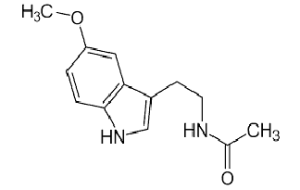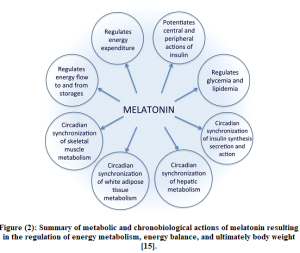Inam Joudah Radhi
Department of Chemistry, College of Education for Pure Sciences, University of Karbala, Iraq.
Abstract:
Chemicals known as hormones are released by the endocrine glands and circulated to the intended organ. It controls how well organs behave and function. In reaction to variations in light, the pineal gland in the brain releases the hormone melatonin.
Keywords: Hormone, Melatonin, and Endocrine glangs.
Introduction:
Hormones are substances that the endocrine glands directly produce into the blood in order to carry out a certain function. In order to coordinate the operation of the body’s organs, hormones often serve this purpose. Some hormones, like growth hormone, are slow-acting while others, like adrenaline, which primes the body for conflict and regulates blood sugar, are vulnerable. Additionally, sex hormones that reveal a person’s gender and sexual preferences [1].
The day’s hormone is connected to the night’s hormone. It serves as an alarm that aids in getting us to sleep and keeping us sleeping through the night. When there is sunlight, it gets smaller. It’s melatonin. Its structural formula is as indicated in Figure No (1). and its molecular formula is (C 13 H 16 N 2 O 2). Additionally, it is a methoxyindole that is mostly produced and secreted at night under typical light and dark conditions by the pineal gland. The suprachiasmatic nuclei produce the endogenous secretion rhythm, which is synchronized with the light/dark cycle. Depending on the light schedule, light has the power to either synchronize or repress melatonin production, see figure(1) [2].

Figure (1): – Demonstrates the hormone melatonin’s chemical makeup [2].
A naturally occurring hormone called melatonin is mostly produced by the pineal gland in the brain. It helps control your circadian rhythm and sleep-wake cycle. About all of its impacts on the human body, researchers still have a lot to understand [3]. Animals’ and humans’ brains’ pineal glands emit it (especially in birds). Since melatonin functions as an antioxidant, it is believed that as melatonin output declines with age in humans, signs of aging and immune system disorders start to manifest. [4]. Additionally, synthetic melatonin can be produced in a lab and sold as a dietary supplement [5].
The function of melatonin in people:
The melatonin hormone is secreted when there is light in the environment, and vice versa; it is secreted, because it governs the cycle of sleep and wakefulness and acts as an alarm clock in the human body, the mechanism by which this hormone works is yet unknown [6]. may take place while at work and when traveling. Melatonin does not appear to have any known psychological effects, but insomnia alone may cause a person to be drowsy in the morning [7].
Synthetic medication:
A medication called melatonin imitates the brain’s normal sleep hormone action. It is used as a short-term treatment for people with primary insomnia, which affects patients 55 years of age and older and is characterized by poor sleep quality. The drug’s apparent success in this generation appears to be due to the brain’s relatively low melatonin production when compared to other treatments. Melatonin does not lead to addiction because it promotes restful sleep for 8 to 12 hours and does not impair attentiveness the following day. Since melatonin’s typical adverse effects include headache, back pain, and weakness, the majority of patients take it well [8].
A low blood melatonin level has been discovered by researchers to be present in all elderly adults as well as those who have sleeplessness. Melatonin has been demonstrated in numerous trials to be effective in treating sleep disorders like trouble going asleep or staying asleep, as well as alopecia in the elderly. Melatonin pills are especially advantageous for people who have successfully utilized tryptophan supplements as a sleep aid because the hormone melatonin is generated in our bodies from the amino acid tryptophan and the brain chemical serotonin (tryptophan supplements are only available with a medical prescription in the form of 5HTP) [9]. Melatonin has a benefit over sleeping pills in that it lessens the disruptions to sleep that can be brought on by medications like benzodiazepines and beta blockers, which are known to prevent the body from producing melatonin. It also lessens sleep disruptions that plague blind persons [10].
Health benefits of melatonin:
Three primary tasks are carried out by the hormone melatonin:
⦁ Regulates your circadian rhythm: Melatonin is typically used by the body to promote sleep by modifying the circadian clock and persuading your body to get ready for bed. Melatonin, then, is a hormone that gets your body ready for sleep but does not actually induce sleep [11].
⦁ Recent research has revealed that melatonin not only impacts the biological clock but also functions as an antioxidant that supports your health. The health of the brain, heart, blood vessels, and digestive system are just a few of the physiological systems it could benefit. Cases [12].
⦁ Immune system booster: Melatonin has a number of potential advantages for your immune system. According to one study, melatonin may aid in the treatment of bacterial illnesses like tuberculosis. Melatonin may be used to treat autoimmune disorders and inflammation, according to a different study [13].
The Melatonin Hormone’s Mechanism [14]:
⦁ A crucial aspect of the regulation of circadian rhythms is the release of melatonin by the pineal gland in the brain.
⦁ The body’s physiological reactions to the 24-hour day-night cycle are known as circadian rhythms.
⦁ Circadian rhythms are controlled by an internal (endogenous) clock, yet they can be affected by outside stimuli.
⦁ Bright light (mostly blue wavelengths) suppresses melatonin release, so levels rise at night.
⦁ Over a prolonged period, melatonin secretion becomes entrained to anticipate the onset of darkness and the approach of day.
⦁ creatures, while conversely encouraging sleep in animals that are nocturnal (like Melatonin functions to promote activity in nocturnal humans).
⦁ Body temperature, brain wave activity, and hormone production all require sleep for proper physiological function, figure (2).
⦁ As people age, their melatonin levels naturally decline, changing their sleeping habits.
References:
⦁ Dooley J, Lok A, Burroughs AK, Heathcote E, eds. Sherlock’s diseases of the liver and biliary system, 12th edn. Oxford: Wiley-Blackwell, 2011.
⦁ Claustrat, B., and J. Leston. “Melatonin: Physiological effects in humans.” Neurochirurgie 61.2-3 (2015): 77-84.
⦁ Claustrat, B., J. Brun, and G. Chazot. “Mélatonine, rythme veille-sommeil et sommeil.” Médecine du sommeil 1.4 (2005): 11-19.
⦁ Schuppan, Detlef, and Nezam H. Afdhal. “Liver cirrhosis.” The Lancet 371.9615 (2008): 838-851.
⦁ Kukula-Koch, Wirginia, et al. “Is Phytomelatonin Complex Better Than Synthetic Melatonin? The Assessment of the Antiradical and Anti-Inflammatory Properties.” Molecules 26.19 (2021): 6087.
⦁ Peschke, Elmar. “Melatonin, endocrine pancreas and diabetes.” Journal of pineal research 44.1 (2008): 26-40.
⦁ Maas, James B. Power sleep: The revolutionary program that prepares your mind for peak performance. Villard, 2012.
⦁ D’Amico G, Garcia-Tsao G, Pagliaro L. Natural history and prognostic indicators of survival in cirrhosis: a systematic review of 118 studies. J Hepatol 2006; 44: 217–31.
⦁ Hytiroglou P, Snover DC, Alves V, et al. Beyond “cirrhosis”: a proposal from the International Liver Pathology Study Group. Am J Clin Pathol 2012; 137: 5–9.
⦁ Marcellin P, Gane E, Buti M, et al. Regression of cirrhosis during treatment with tenofovir disoproxil fumarate for chronic hepatitis B: a 5-year open-label follow-up study. Lancet 2013; 381: 468–75.
⦁ Garcia-Tsao G, Friedman S, Iredale J, Pinzani M. Now there are many (stages) where before there was one: in search of a pathophysiological classifi cation of cirrhosis. Hepatology 2010; 51: 1445–49.
⦁ Wu, Ying‐Hui, and Dick F. Swaab. “The human pineal gland and melatonin in aging and Alzheimer’s disease.” Journal of pineal research 38.3 (2005): 145-152.
⦁ Ma, Ning, et al. “Melatonin mediates mucosal immune cells, microbial metabolism, and rhythm crosstalk: A therapeutic target to reduce intestinal inflammation.” Medicinal Research Reviews 40.2 (2020): 606-632.
⦁ Vanecek, Jiri. “Cellular mechanisms of melatonin action.” Physiological reviews 78.3 (1998): 687-721.
⦁ Cipolla‐Neto, Jose, et al. “Melatonin, energy metabolism, and obesity: a review.” Journal of pineal research 56.4 (2014): 371-381.






























































